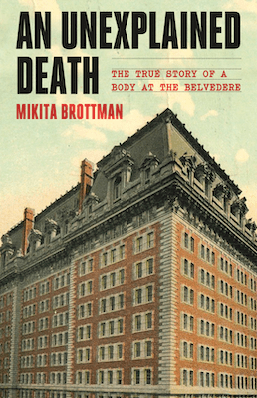A Man Died in Mikita Brottman’s Apartment Building, and She Attempts to Solve the Case in An Unexplained Death

What makes a death mysterious? Is it a lack of evidence, or a pit in our stomachs? In Mikita Brottman’s new book, An Unexplained Death, the answer is a bit of both.
When a young man’s body was found in her Baltimore apartment building, Brottman set out to solve the case. Rey Rivera was 32 when he abruptly left his home after receiving a phone call on May 16, 2006. His friends and family, including his wife Allison, searched for a week before his body was found at the Belvedere in an area that once housed a swimming pool but had since been divided into office space. It appeared that Rivera had died by suicide, having jumped off the Belvedere’s roof before breaking through a secondary, lower roof during his fall. While the coroner ruled it an “undetermined” cause of death, those who knew Rivera weren’t convinced he would take his own life.
They suspect murder.
 Brottman isn’t convinced, either. She lives in the Belvedere and believes she may have heard Rivera’s impact with the lower roof on the night he died. A self-described obsessive when it comes to the unexplained and morbid, Brottman’s fixation with the case ignites a 10-year effort to discover what truly happened to Rivera in the six hours between when he left his home and is believed to have died.
Brottman isn’t convinced, either. She lives in the Belvedere and believes she may have heard Rivera’s impact with the lower roof on the night he died. A self-described obsessive when it comes to the unexplained and morbid, Brottman’s fixation with the case ignites a 10-year effort to discover what truly happened to Rivera in the six hours between when he left his home and is believed to have died.
“What could make a stable, gregarious, newly married man who had just made plans for the weekend suddenly jump off a building?” Brottman writes.
The case’s puzzle pieces are confounding, and Brottman uses them to create an atmosphere of conspiracy. The Belvedere itself is a fascinating setting; built in 1903, the Baltimore hotel-turned-apartment-complex has been through the ringer. Once a destination, it struggled financially for decades before reaching its current iteration. It’s still used for events and parties, with multiple bars and a near labyrinthine layout that makes it sound like a building designed for stories of death and dismay. And there have been many—including murders and suicides by jumping or by poison. The Belvedere feels like a beacon for those nearing death, and Brottman places Rivera within a much larger, haunting tale of the building’s mysteries.
But Rivera didn’t seem like someone who would commit suicide. A freelance video editor, he was on deadline the day he died and had reserved space to work on the project over the weekend. Rivera and Allison were planning on moving back to LA from Baltimore in the near future, a move they both seemed excited about. He was described as a happy, loving, warm person who gave no indication of distress.
Except that characterization, as Brottman explains, isn’t the whole picture. Rivera had also been showing signs of stress, with paranoia increasing in the days before his death to the point where Allison believed he was being followed. By whom? Perhaps someone from Agora, the shady investment strategies group he worked with and from which the final call made to his phone—the call that prompted him to leave home the day he died—came. Under the Agora umbrella is Stansberry Research, founded by Rivera’s old friend Porter Stansberry, who helped Rivera land the job that brought him to Baltimore. Stansberry later became cagey with police, putting multiple lawyers between himself and the investigators looking into Rivera’s death. As Brottman learns more about Agora and Stansberry, she’s repeatedly warned that people will go a long way to make sure the “real story” stays hidden. Even the police aren’t helpful, making Brottman suspect a possible cover up.
It’s easy to get wrapped up in the case, even though Brottman isn’t an investigative journalist or a true crime writer. She acknowledges her shortcomings, explaining how her self-consciousness gets in the way of being a dogged reporter. Brottman also shares asides throughout the book about her own insecurities, sometimes even exploring the deaths of animals or describing her neighbors in the Belvedere. None of these are ever quite connected Rivera’s story, but they build upon the book’s evocation of sinister uncanniness and disquiet. If at times they can become rambling, these asides are a reminder that this crime book is something wholly unique.
In the end, An Unexplained Death is more about mystery itself than about a mystery. Rivera’s death, which Brottman views in a light that serves as a satisfying twist, is the scaffolding on which she builds a larger meditation on the dark obsessions we develop. There are questions we will never answer and truths we will never accept. But Brottman’s book encourages us to explore beyond our comfort zone, hinting at the possibility for significant discoveries…even they’re never fully revealed.
Bridey Heing is a writer based in Washington, DC. More of her work can be found here.